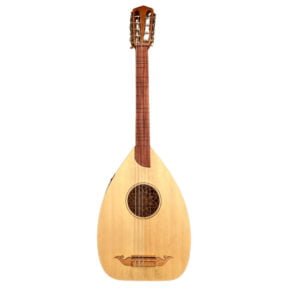- Call us
- Via Vicolo Galletti 2 , 48013 Brisighella (RA) / Italy
- WORLDWIDE FREE SHIPPING
Turkish Lavta
Lavta: A String Instrument from Istanbul
The Lavta is a plucked string instrument historically played in Istanbul, particularly among Greek, Armenian, and Turkish communities. Resembling a lute, it has a characteristic sound between the oud and the tanbur. While its exact origins remain unclear, the Lavta enjoyed popularity in the 19th and early 20th centuries, often accompanying fasıl music ensembles.
Showing all 3 results
-
Sale!

Turkish Lavta – Light Of Tradition
€ 849,79Original price was: € 849,79.€ 699,01Current price is: € 699,01.Read more- USD: $773,48
-
Sale!

Turkish Lavta | Electro Acoustic Lavta | Luito Turco | Luth | Turkish Lute
€ 900,00Original price was: € 900,00.€ 760,26Current price is: € 760,26.Add to cart- USD: $841,25
-
Sale!

Turkish 5 Strings Lavta (Lute) – Electro Acoustic Special Desing
€ 979,23Original price was: € 979,23.€ 849,17Current price is: € 849,17.Add to cart- USD: $939,63
A Turkish Lavta Treasure Trove of Tone, Tradition, and Modernity
A captivating stringed instrument with a pear-shaped body and an elongated neck, is more than just an aesthetic wonder. Its meticulously crafted design unlocks a world of versatile tones and enthralling resonance. Built with the finest tonewoods, the instrument embodies the artistry and skill of its makers, adding a unique voice to the rich tapestry of world music.
A Symphony of Sound: Unveiling Tonal Palette
One of this traditional instrument defining characteristics is its resonant tone. The instrument’s body, typically constructed from hardwoods like rosewood or walnut, provides a solid foundation. This is meticulously paired with a soundboard crafted from spruce or cedar, chosen by the luthier (instrument maker) for its ability to project sound with both warmth and vibrancy. The resulting sound is rich and complex, capable of captivating audiences across genres.
Beyond Beauty:Expressive Capabilities
This Turkisn Traditional isn’t just pleasing to the eye; it’s renowned for its ability to produce melodious and expressive music. Its fretted neck allows for precise intonation, enabling players to effortlessly execute intricate melodies. This precision makes the Lavta an essential instrument in both Turkish classical music and traditional folk music. Composers and performers leverage its expressive capabilities to weave stories through music, conveying a range of emotions that resonate deeply with listeners.
A Journey Through Time: From Ottoman Origins to Modern Revival
It is holds a significant place in Turkish music history, with roots tracing back to the Ottoman Empire. It emerged from the rich musical traditions of Persia and the Arab world, carrying influences that continue to shape its sound. Over time, instrument carved a unique niche for itself within Turkish culture, becoming a beloved instrument cherished by musicians and audiences alike.
Unveiling the Traditional Lavta: Design and Construction
The traditional Lavta typically features a round body, crafted from tonewoods like maple or beech. This rounded shape contributes to the instrument’s warm sound. A soundboard adorns the top of the body, further enhancing the tonal character. Six pairs of metal strings, traditionally made from gut, are tuned using pegs at the headstock. This traditional construction allows the Lavta to produce its signature sound, a sound that has captivated musicians for centuries.
A Phoenix Rising: The Lavta’s Resurgence in Modern Music
While this trditional musical instrument popularity waned in the 19th century due to evolving musical trends, recent times have witnessed a remarkable resurgence. This renewed interest has ensured the Lavta’s return to the forefront of the Turkish music scene, attracting a new generation of musicians captivated by its unique sound and historical significance. Modern players are not only preserving traditional techniques but also pushing boundaries by incorporating the instrument into contemporary music genres.
Enduring Allure: A Legacy that Continues to Inspire
The Turkish Lavta embodies a rich legacy, carrying the echoes of past masters while simultaneously captivating modern musicians. Its versatile sound, expressive playing style, and historical significance make it a truly remarkable instrument. Whether encountered in a traditional folk ensemble, a contemporary fusion band, or a captivating solo performance, the Turkish Lavta continues to weave its magic, ensuring its place in the hearts of music enthusiasts for generations to come.
Free Shipping
To Europe & %0 Custom Tax
15 Days Warranty
15 days money back
Global Shipping
Worldwide Shipping
100% Secure
100% Secure Checkout

